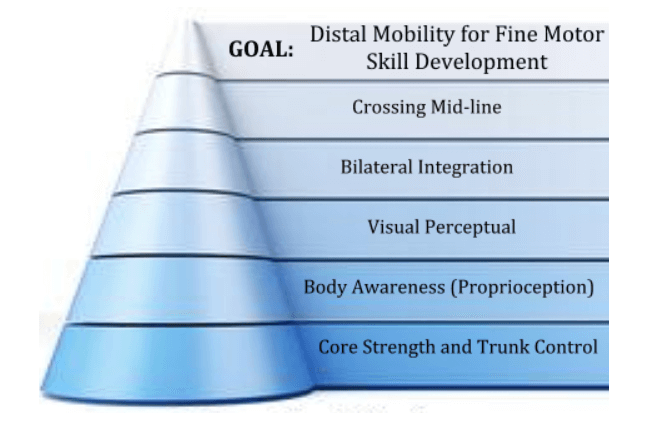By: Stephanie Johler MS, OTR/L
Fine motor skills are those that involve the intrinsic muscles (small muscles) of the hands, fingers, and forearms. Fine motor skills develop over time and allow for crucial movements such as reaching, grasping, moving, and manipulating objects. In building these fine motor skills, it allows the child to independently perform essential everyday activities such as self-care (dressing, eating, hygiene), playing, and engaging in academic activities.
Let’s think about fine motor development like building a pyramid – one must start at the base level and build up in order to have a strong, sustained, and refined structure.

Stage 1: Promoting a Strong Base
When facilitating fine motor development, proximal stability promotes distal mobility. This means that in order to achieve refinement of fine motor skills, we must first achieve stable proximal structures, such as our core and mid-line musculature/structures. As an example, young babies have a lot of mobility but not a lot of stability, or muscle control. They develop the stability in the head and trunk first. Once they have established a stable base, they start to roll over, sit up, and eventually reach with their arms, pull themselves up, stand up, and walk. All of those developmental milestones cannot be achieved until they have created a strong and stable base.
How can you strengthen the core and improve trunk control?
- Animal walks: bear crawl, frog jumps, crab walk, snake curls, donkey kicks, inchworm crawl
- Wheelbarrow walk races
- Superman poses
- Log roll bowling (use your body as the bowling ball!)
- Cha-cha slide in plank position
Stage 2: Body Awareness (Proprioception)
Body awareness is the ability to sense where all of your body parts are positioned in space. It also includes how each of those parts works together and separately to perform a specific action. The brain receives information from our muscles and joints to inform us of our body position and movement. This way we can accurately control our intended movements. This is important for fine motor development in order to accurately and precisely manipulate the forearms, hands, and fingers to complete a task.
How can you improve body awareness?
- Mirror Mimic- imitate a partners movements in a mirror
- Heavy Work- activities of pulling, pushing, and carrying against resistance
- Yoga- use pictures of poses that the child has to recreate
- Balloon volleyball
- Jump on trampoline
Stage 3: Visual Perceptual Skills
Visual perception is the brain’s ability to make sense of what the eyes see. This allows the child to focus and interact with his/her environment appropriately. Fine motor development depends on strong visual perceptual skills in order to complete fine motor skills such as: accurately identifying colors, shapes, and patterns for graphomotor tasks, forming letters during handwriting from visual memory, picking up objects from a busy background and so much more.
How can you improve visual perceptual skills?
- Puzzles
- Connect the dots
- Create matching towers and trains with building blocks
- I-Spy
- Matching games
- “Which one is not the same?”
- Sticker books
Stage 4: Bilateral Integration
Bilateral integration is the ability to use both sides of your body in a coordinated way. Specifically for fine motor development, the capability of using both sides of the trunk/core as well as using bilateral upper extremities together is important when carrying out fine motor tasks. Examples include: during graphomotor activities using one hand to write and the other to stabilize the paper, using one hand to manipulate the paper while the other hand cuts with scissors, tying shoelaces, zippering and buttoning clothing, putting toothpaste on a toothbrush, etc.
How can you improve bilateral integration?
- Play catch
- Tug of war
- Rolling playdoh
- Stringing beads to make jewelry
- Zoom Ball
Stage 5: Crossing Midline
Midline indicates the imaginary median line or plane down the center of your body. Crossing midline refers to the ability to reach across the middle of your body with your arms or legs over to the opposing side. With the ability to cross midline, when a dominant hand becomes prevalent, it has the ability to strengthen and get the necessary practice needed in order to develop fine motor skills. Otherwise, the inability to cross midline requires the child to switch hands constantly. This switching inhibits the capability to strengthen and refine a single hand fine motor skill, such as writing, eating, and hygiene.
How can you improve crossing midline?
- Twister
- Throw a ball at different targets positioned on left, right, and in the center while in a stationary position
- Paddle games such as ping pong or badminton
- Simon Says using one hand
- Flashlight tag
- Scoop or transfer objects from a bucket on the left to a bucket on the right
For more information about fine motor development and to see how one of our therapists can help your child, contact us today!

